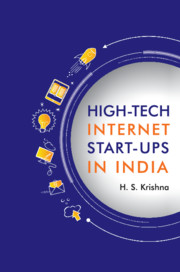Book contents
- Frontmatter
- Dedication
- Contents
- List of Tables
- List of Figures
- Preface
- Acknowledgements
- 1 Introduction
- 2 Objectives, Scope, and Methodology
- 3 High-tech Start-ups in India: Profile and Characteristics
- 4 Emergence of High-tech Start-ups
- 5 Survival of High-tech Start-ups
- 6 Growth of High-tech Start-ups
- 7 Factors influencing Life Cycle of High-tech Start-ups
- 8 Conclusions
- Bibliography
- Index
3 - High-tech Start-ups in India: Profile and Characteristics
Published online by Cambridge University Press: 12 June 2019
- Frontmatter
- Dedication
- Contents
- List of Tables
- List of Figures
- Preface
- Acknowledgements
- 1 Introduction
- 2 Objectives, Scope, and Methodology
- 3 High-tech Start-ups in India: Profile and Characteristics
- 4 Emergence of High-tech Start-ups
- 5 Survival of High-tech Start-ups
- 6 Growth of High-tech Start-ups
- 7 Factors influencing Life Cycle of High-tech Start-ups
- 8 Conclusions
- Bibliography
- Index
Summary
Introduction
This chapter describes the profiles and characteristics of the high-tech start-ups in our sample. To start with, we analyse the univariate profiles of the start-ups with respect to their characteristics, such as year of incorporation, number of founders at the time of creation, gender distribution of primary founders, number of founders who knew each other prior to the starting of the enterprise, and the location of operations of the start-ups.
Further, univariate and bivariate analyses of the characteristics are carried out based on the market segment that these start-ups are catering to (B2B versus B2C), the location of operations of the start-ups (North Zone versus South Zone), and the entrepreneurial background of the founders (local entrepreneurs versus transnational entrepreneurs). There are 275 start-ups that constitute our sample for the study. Out of these, 100 start-ups are informally active (not emerged), 88 of them have emerged but have not survived, 38 of them have survived but have not yet grown, and 49 of them have grown. The rest of this chapter is organized as follows. The next section discusses the results from univariate analysis. The following section analyses the bivariate relationships of the characteristics and the last section summarizes the major observations based on the univariate and bivariate analyses carried out.
Profile of the Start-ups: Univariate Analysis
The profiles of the high-tech start-ups in our sample are analysed with respect to the characteristics mentioned earlier. Each of these characteristics has been discussed in detail here.
Year of Incorporation
Figure 3.1 presents the distribution of high-tech start-ups, based on their years of incorporation. The figure indicates that there has been more or less a steady increase in formal incorporation of the start-ups post the 2008 financial crisis. In particular, the rate of inceptions of the start-ups in our sample has doubled in the past two years – consistent with the observations made by NASSCOM (2015).
Number of Founders at Inception
Figure 3.2 presents the distribution of high-tech start-ups, based on the number of founders present at the time of creation of the start-up. About 50 per cent has start-ups with two co-founders. For most of these start-ups, one of the founders focused on the technological aspect of the start-up, while the other co-founder focused on the business aspects of the start-up.
- Type
- Chapter
- Information
- High-tech Internet Start-ups in India , pp. 47 - 74Publisher: Cambridge University PressPrint publication year: 2019



